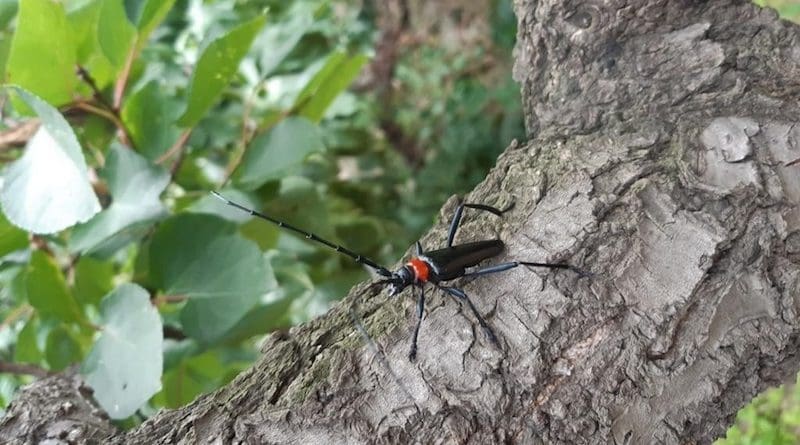Study Explores Biology, Impact, Management And Potential Distribution Of Destructive Longhorn Beetle
A new study, published in the Journal of Pest Science, explores the biology, impact, management, and potential distribution of the invasive, red-necked longhorn beetle (Aromia bungii) which has recently invaded Japan, Germany, and Italy.
The review is mainly based on Chinese literature and intended to reveal the rather concealed but present knowledge to a wider audience, especially for those countries that were recently invaded or are at threat to be invaded.
The insect is regarded as one of the most destructive longhorn beetle pests of fruit trees in lowland areas of China where economic losses to Prunus species, such as apricot and peach, can be substantial and threaten economic development and food security.
In Italy, the UK Department for Environment, Food & Rural Affairs (Defra) states, Aromia bungii has severely damaged or killed several hundred apricot, cherry and plum trees that have succumbed to larval attack that leads them to become more susceptible to disease.
Aromia bungii is native to the south-eastern Palaearctic and Oriental regions. It is recorded from China, Japan, Mongolia, North Korea, Taiwan, Vietnam, and the Russian far East.
Sustainable control tools are needed
Scientists from the MARA-CABI Joint Laboratory for Biosafety and European Laboratory joined colleagues from Agriculture and Agri-Food Canada, Agroscope and the Institute of Plant Protection, Chinese Academy of Agricultural Sciences (CAAS) on the study which highlights that sustainable control tools are needed for the management of this emerging pest.
The study further demonstrates the great international, intercontinental collaboration for this review involving scientists from China, Switzerland, Italy, Germany, and Canada.
Dr Tim Haye, Head Arthropod Biological Control at CABI, and an author of the paper, said, “The pest exhibits an adaptable lifecycle, a high reproductive output, and the larvae live concealed under the bark of invested trees, which are traits that promote its invasiveness.
“Detection and monitoring of A. bungii currently rely upon visual identification of infested trees that are usually already damaged, which is inefficient and not target-specific.”
Dr Haye said current control methods rely upon the labour-intensive physical removal of infested trees. Although native parasitoid natural enemies of A. bungii provide control in Chinese orchards, none are appropriate for classical biological control in invaded areas due to biosafety concerns surrounding their broad host ranges. However, entomopathogenic fungi and nematodes may provide viable options for biological control in invaded ranges.
Targeted natural enemy surveys
Dr Jinping Zhang, of the MARA-CABI Joint Laboratory for Biosafety, said, “Recent advancements in semiochemical baited traps may provide sustainable, target-specific, and efficacious methods to monitor and control A. bungii.
“There remains much to learn about the biology and control of A. bungii, and continued advancements in the study of sustainable control tools are needed for the management of this emerging pest.”
The scientists argue that classical biological control against A. bungii may not be viable due to biosafety risks, but targeted natural enemy surveys would provide greater clarity on the potential for this approach.
Dr Haye added, “This review ultimately provides a source of reference for A. bungii that can be used by scientists, regulatory agencies, and industry to direct future research and implementation of management options.”

